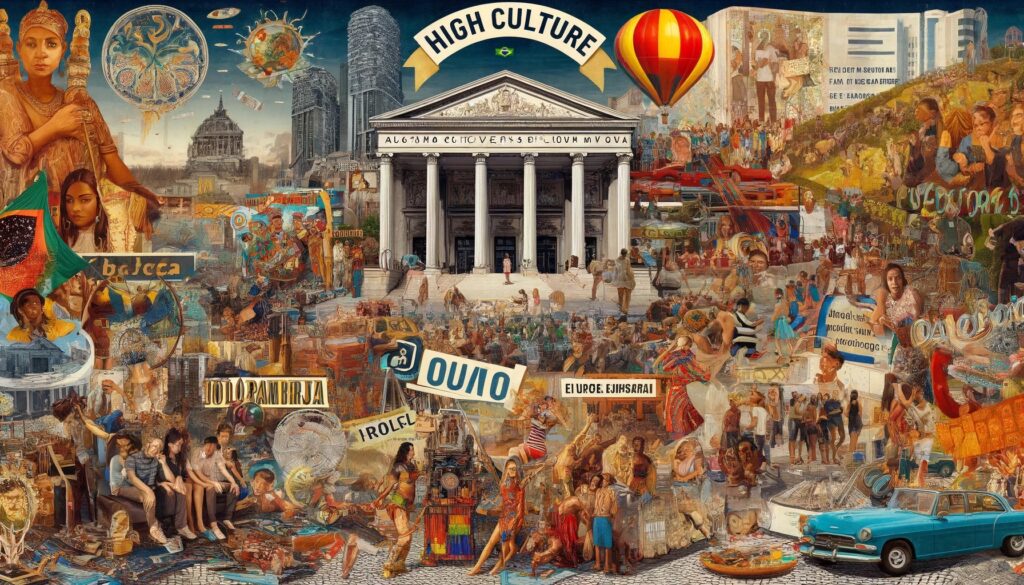Some months ago, I joined Lee Moreau, Lesley-Ann Noel, and Alicia Cheng in the inaugural episodes of the Design As podcast (Apple/Spotify), connected to the Design Observer project. We discussed Design as Culture. The conversation was so rich and dense that we split it into two parts. Luckily, Design Observer published a transcript for those not willing to listen to our two-hours conversation. For the sake of archiving my thoughts, I’ll share excerpts of my talk. I highly encourage readers to listen to the other voices in the full episodes, as I could not have come up with these without their dialogical partnership.
Talking about this topic is almost a never-ending discussion, right? I would say that culture can have many meanings. The common understanding relates to customs, habits, food, and art styles. However, this is a superficial understanding of what is visible in culture. There are always more invisible structures that are not easy to discern, distinguish, or identify. If we delve deep into understanding culture, we might also see conflicts and contradictions, especially between habits and customs considered low culture and those considered high culture. For example, visiting a museum is considered high culture, while attending certain music style parties is considered low culture. This contradiction also spreads through different regions of the world. Some countries are seen as having a mission to conserve high culture, while others are viewed as destroying culture. For instance, the U.S. is often seen as destroying European culture, which Europeans try to conserve. Brazilians are also seen as part of this destructive trend, but this destruction sometimes creates new forms of culture. Thus, culture can be understood as dynamic, a way of overcoming these contradictions. Culture is something we cultivate and change, much like the way we eat. Our food cultures change across centuries, which is why it’s important to have a history of culture. You cannot understand culture without understanding its past and future history. This is perhaps where design comes in.
Excerpt from Design As S1E1: Culture Part 1
I did not mention it in my talk, but I had the concept of cultural alienation of Álvaro Vieira Pinto at the back of my mind, which influenced Paulo Freire’s anthropological concept of culture. In Ciência e Existência (1969), Vieira Pinto writes:
Cultural alienation is the stage of consciousness in which people are unable to conceptualize the ideas possessed by themselves and for themselves, and therefore only uses ideas for their value as consumer goods.
Instead of drawing a boundary between a high and low culture within one culture, like done in Adorno and Horkheimer’s (1972) culture industry concept, cultural alienation is about intercultural relations.

The alienated culture is unaware of having its own due to borrowing from another, typically a former colonizer culture. They borrow so much that they even borrow their concept of culture, like the one devised by Adorno and Horkheimer. High and low distinctions are, thus, imported hierarchies that preserve the coloniality of making and other forms of coloniality. They are not liberating for nations like Brazil and cannot be overcome by a simple denial.
And that’s a contradiction we experience in everyday life here in Brazil. Many people in colonial or former colonial settings believe that if they have inheritance from the colonizers, they still have a culture of the colonized to maintain. Even though Brazil has been politically independent for 200 years, culturally, we are still tied to Europe and more recently to the U.S. culture. These cultures are presented to Brazilians as high culture. But what about design? Is design high culture or low culture? In the past, design was considered applied art for the masses, low culture. But now, design is entering museums and could be considered high culture. In the U.S., this distinction might not hold, but in Brazil, design is definitely high culture, at least canonical design. Everything else that people do in the streets, for example, the material culture produced by everyday people not trained in design, is considered low culture or no design at all.
Excerpt from Design As S1E1: Culture Part 1
To overcome cultural alienation, alienated people must understand its origins and reframe low culture as the authentic culture. That is what I tried to do in my contributions to this podcast: to leverage the design found on the streets, design of the people, popular design.
In Brazil, we even use the word “design” coming from Anglophone influences. We don’t use a Brazilian word for that. If we want to use a Brazilian word, we use “projeto,” which is considered not fashionable. It’s not cool enough. If you say “design,” it’s something well done, right? But something done by Brazilians in their own way is just “projeto,” or even worse, “gambiarra.” We have this specific Brazilian word for a bad design that is improvised based on available materials, essentially upcycled things. They call it “gambiarra,” but it’s considered lower design in relation to formal design, or not really design at all. Our work in the laboratory is to tell students: Look, this is the kind of design we can do here in Brazil. If we design from “gambiarra” and develop it further, we might create something much more relevant to our Brazilian culture than if we start designing the way designers do abroad.
Excerpt from Design As S1E1: Culture Part 1
My students are initially skeptical about such reframing of design and culture. They pursued higher education to achieve some sort of superiority in their designs and in their designer status.
If you look at design history, you’ll see that many designers have created things that represent and synthesize culture in a material way. These designs can be used in everyday life for functional purposes, but they can also be displayed in museums as statements about historical times, capturing the spirit of the times. This idea attracts many design students who want to become famous designers. However, they often believe they don’t know anything about producing culture and see it as something to acquire, like putting something in a Chanel bag and taking it with them. In our laboratory of design against oppression, we try to deconstruct this notion. We show students that they are already producing culture, even if they are not recognized as famous designers. They are everyday designers, constantly designing their lives, bodies, and how they present themselves in society. This is already a form of design. As they go further, they realize they are culture producers as citizens. If you are breathing and part of society, you are already producing culture. This realization is liberating because culture is not something distant or unattainable. It’s something they already have, which empowers them to pursue their own paths instead of following someone else’s.
Excerpt from Design As S1E1: Culture Part 1
However, as we progress into problematizing the role of design in cultural alienation, they come to realize that what they don’t know about design that they think they need to know has been designed to appear as such: a cultural barrier to becoming a recognized designer. This is particularly daunting for disenfranchised students who dream of leveraging their education for social mobility.
If they start from reading the world to reading the words, there is a connection. It’s not something imposed by someone else to divide high culture and low culture, literate and illiterate. No, it’s a continuum. You can always develop further, even if you are already literate. There’s so much more to read and also to write. You can also be a culture producer on your own. That’s why Paulo Freire always said that we are part of culture. We are culture. Actually, that’s the definition: humans are culture.
Excerpt from Design As S1E1: Culture Part 1
I acknowledge that this discussion might seem detached from the current design practice and education. Yet, this is precisely due to the phenomenon I am underlining here: cultural alienation. Here is what happens when design students become aware of that. In her final work in graphic design degree at UTFPR, Polyana de Andrade Tavares developed critical consciousness on cultural alienation through personal reflection, critical pedagogy, and collective action. Using autoethnography, she examined her engagements in the Design & Oppression Network. By sharing her narrative publicly and advocating for transformative design practice, Polyana came to the conclusion that designers are cultural producers and should, therefore, act more consciously to fight cultural alienation in their territories and communities.
Having the opportunity of working with Polyana and other LADO students led me to state this final thought on design education in the podcast conversation:
We’re not just making things; we are also making ourselves. Approaches like the positionality wheel help us become aware and self-conscious about this process of making ourselves while making things for others. We always imbue our values, habits, cultures, and the contradictions we experience into the things we create. Understanding where we are sourcing things from and expressing them deeply helps us contribute to our culture. This is probably an overlooked issue in design education. We don’t usually think about design education as citizen training; we think about professional training. But before being a professional, you are a citizen in the world, and understanding your place and its history is crucial. Besides being a professional, you are also responsible for many other things. Learning about your own positionality and its relation to material culture and privileges is important. For example, have you ever had access to an ergonomic chair like the one you are sitting on now? The kind of design you’ve had access to throughout your life impacts and limits the kind of person you can become because you make yourself based on the materials around you, whether they are designed or un-designed like the “gambiarras” I mentioned earlier. If you make yourself out of a “gambiarra,” can you really become a designer? What kind of designer will you become? If you design based on “gambiarra” and then make a statement that this is still design, you broaden the scope of design education. This broader approach is much needed right now because, as Lesley-Ann mentioned, there are not many secure jobs for all students. However, society needs people who can handle these harsh contradictions and create new roles beyond the professional realm.
Excerpt from Design As S1E2: Culture Part 2
As a design educator, it is my moral duty to counter cultural alienation. However, I also see that changing societies requiring people like our former student Polyana: good theoretical practitioners, committed activists, coalition articulators, material speculators, environmental bricoleurs, socialist entrepreneurs, everyday politicians, and many new ways of being designers in the face of strong contradictions. My engagement with the decolonizing design movement aims at overcoming cultural alienation in former colonial worlds but not just that. There are other forms of alienation to be unveiled in other worlds.
If you have come all the way here, please listen to the entire podcast episodes linked above. We covered so many other topics that are currently neglected in design education and practice.
References
Moreau, Lee (Host); Cheng, Alicia; Van Amstel, Frederick; Noel, Lesley-Ann. (2023). Design As S1E1: Culture Part 1. Design As [Audio podcast]. Design Observer. https://designobserver.com/design-as-s1e1-culture-part-1/
Vieira Pinto, Á. (1969). Ciência e existência problemas filosóficos da pesquisa científica. Rio, Paz & Terra.
Max Horkheimer; Theodor W. Adorno (1972) [1947]. Dialectic of Enlightenment. Translated by John Cumming. New York: Herder and Herder. ISBN 0-8047-3633-2. OCLC 48851495.

